United States messaging content requirements
Last updated: 04/04/2025These guidelines are relevant for SMS, MMS and RCS compliance in USA.
CTIA - US SMS messaging programs
In the US, the CTIA is the governing body for all text messaging programs to protect consumers from unwanted messages, which all message senders must abide by, in addition to the Wireless Providers’ code of conduct and best practices.
To ensure a compliant program meets the minimum CTIA requirements, it’s best to ensure your program includes the following guiding principles and short code program components.
Call-to-action (CTA)
The purpose of a call-to-action (CTA) is to ensure the consumer consents to receive text messages and understands the nature of the program. The CTA language must encourage or invite a consumer to opt into a messaging program and must be clearly and unambiguously displayed with the following disclosures:
- Program (brand) name or product description.
- Message frequency disclosure.
- Message and data rates may apply (if non-FTEU).
- STOP keyword (opt-out information may appear in the terms and conditions).
- Complete terms and conditions or a link to complete terms and conditions (pop-ups are not a method for displaying terms and conditions).
- Privacy policy or a link to a privacy policy.
User consent
Messaging programs are expected to provide full transparency so that consumers are aware of and only receive messages from messaging programs to which they have opted in.
Opt-in
Consumers must opt-in to receive messages associated with a specific program. Enrolling a consumer in multiple programs based on a single opt-in is prohibited, even when all programs operate on the same short code.
Opt-out
Message senders must acknowledge and act on all opt-out requests. Monitoring procedures confirm a successful opt-out.
Privacy policy
Message senders are responsible for protecting the privacy of consumers’ information and must comply with applicable privacy laws. Message senders should maintain a privacy policy for all programs and make it accessible from the initial CTA.
Terms and conditions
Comprehensive terms and conditions can either be displayed in full directly below the CTA or accessed from a link close to the CTA. The essential requirements for the Terms and Conditions are straightforward. However, many brands choose to include additional details or incorporate an SMS section into their existing terms and conditions.
Do not use pop-ups for displaying terms and conditions.
Where feasible, message senders may combine multiple program components (for example, call-to-action and terms and conditions)
You must disclose the following in the Terms and Conditions:
- Program or brand name
- Message frequency disclosure (not required for single message programs)
- Description of the program
- Customer care contact information
- Opt-out information (not required for single message programs)
- "Message and data rates may apply" disclosure (not required for FTEU rated programs)
For more details about CTIA messaging requirements, see the CTIA Messaging Monitoring Program Handbook and the CTIA Messaging Principles and Best Practices on Industry guides for USA and Canada.
US - Program message flow key elements
A messaging program’s message flow consists of the following:
Opt-in confirmation
Messaging programs should send a single opt-in confirmation message displaying information to verify the consumer’s enrollment, identify the program, and describe how to opt out.
Additionally, opt-in messages must contain the program (brand) name or product description, customer care contact information, message frequency disclosure, “message and data rates may apply” disclosure (non-FTEU), and opt-out instructions (reply STOP to opt-out).
HELP
Message senders must send a HELP message after consumers text the HELP keyword. Short codes must reply with the program’s name and additional contact information for consumer help.
Opt-out
Message senders send an opt-out message after consumers text a keyword indicating they wish to opt out (for example, STOP, END, CANCEL, QUIT, UNSUBSCRIBE). The opt-out message must include the program’s name and confirm that the consumer has been opted out of the program.
Example: Web recurring opt-ins
Call-to-action for recurring message with standard web opt-in

Call-to-action for recurring message with opt-in on web form
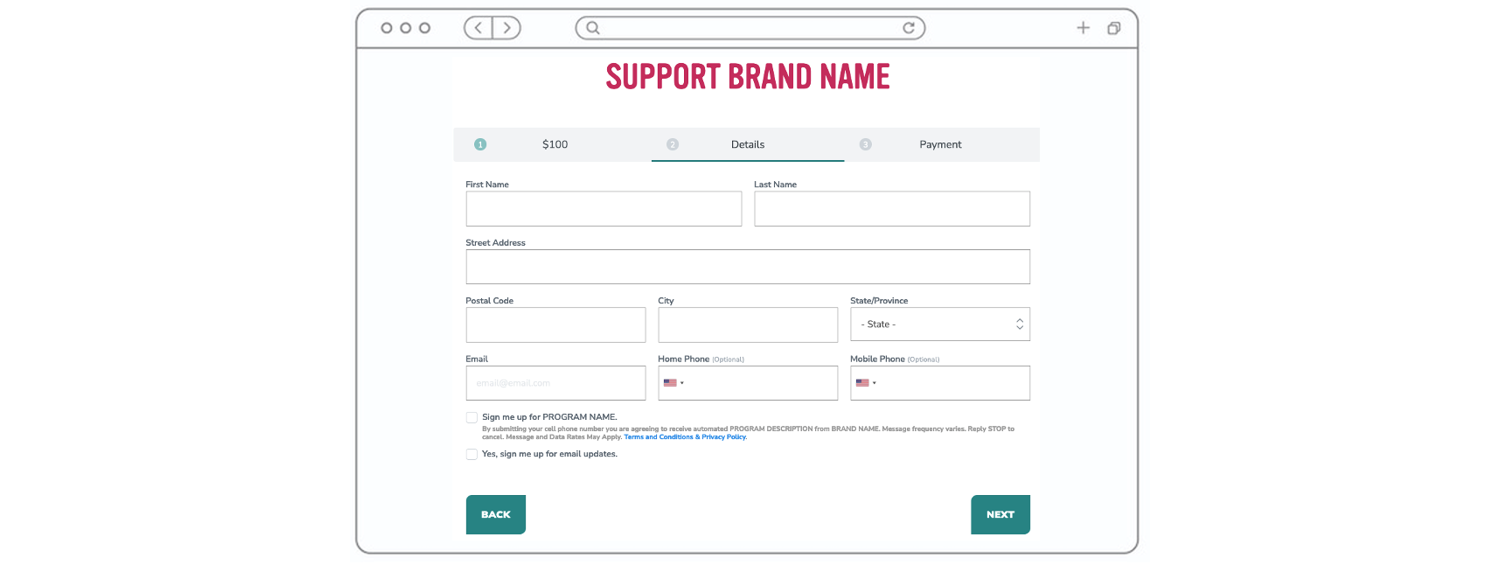
Call-to-action for recurring message with web opt-in on pop-up
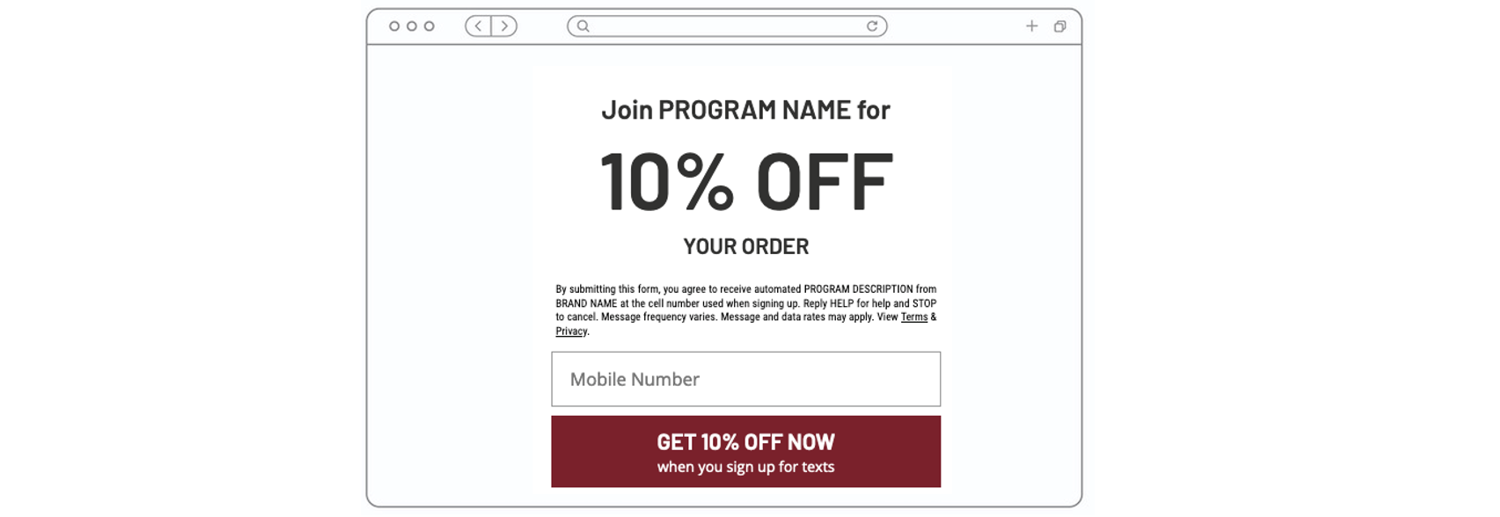
Message flow - Example confirmation MT for web opt-in
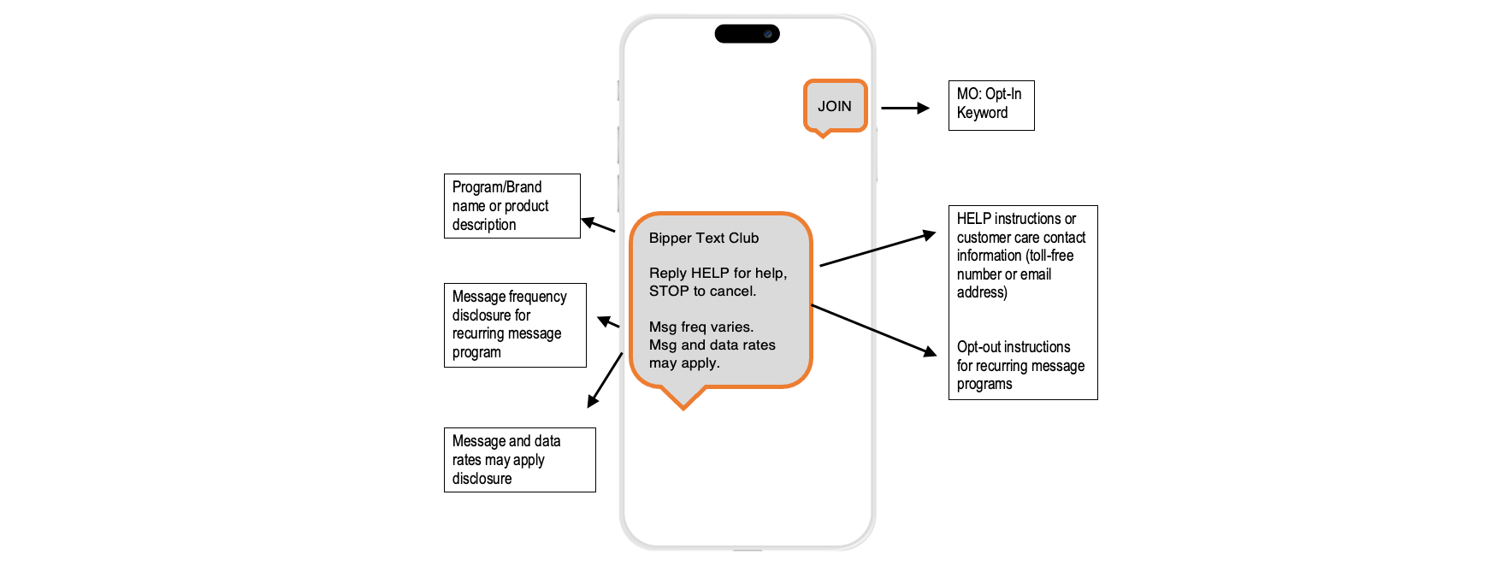
Example: Web opt-in for single message program
Example: Call-to-action for one-time passcode (Step 1)
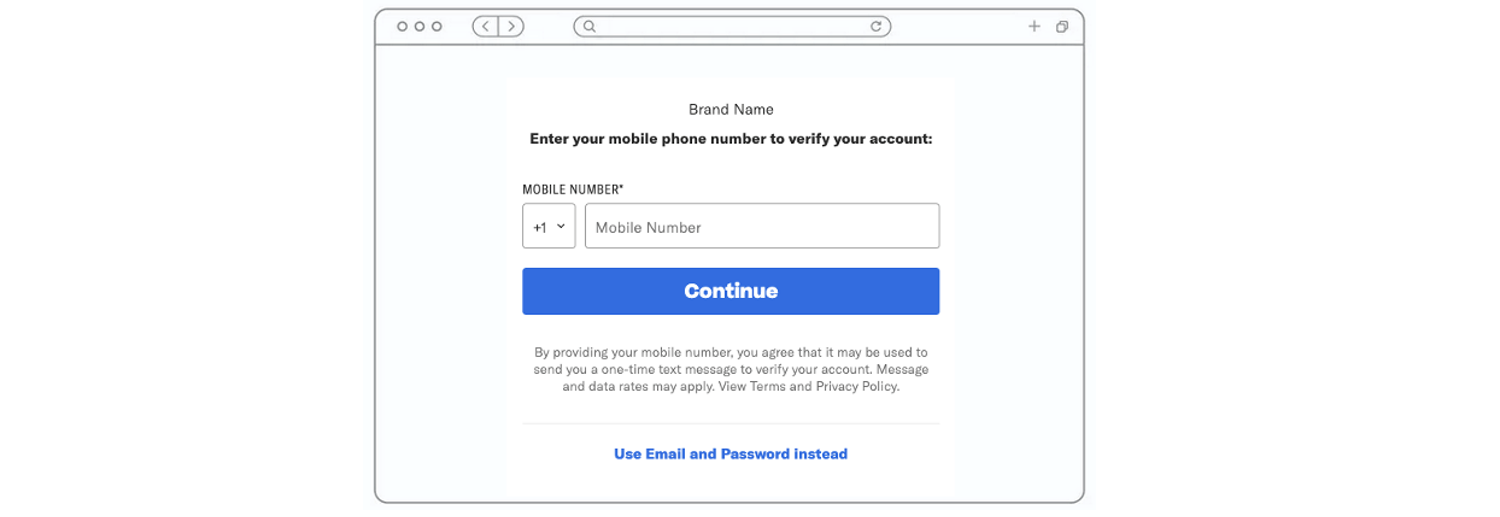
Example: Call-to-action for one-time passcode (Step 2)
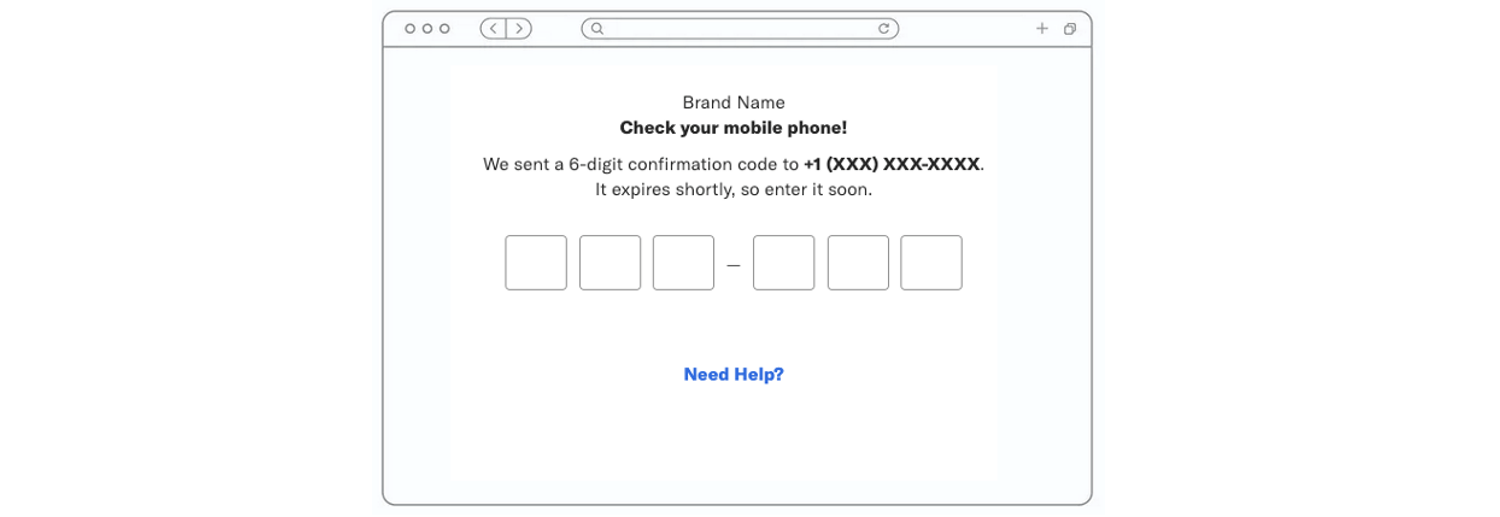
Message flow - Example MT for once-time 2FA code

Example: Call-to-action for single message app download
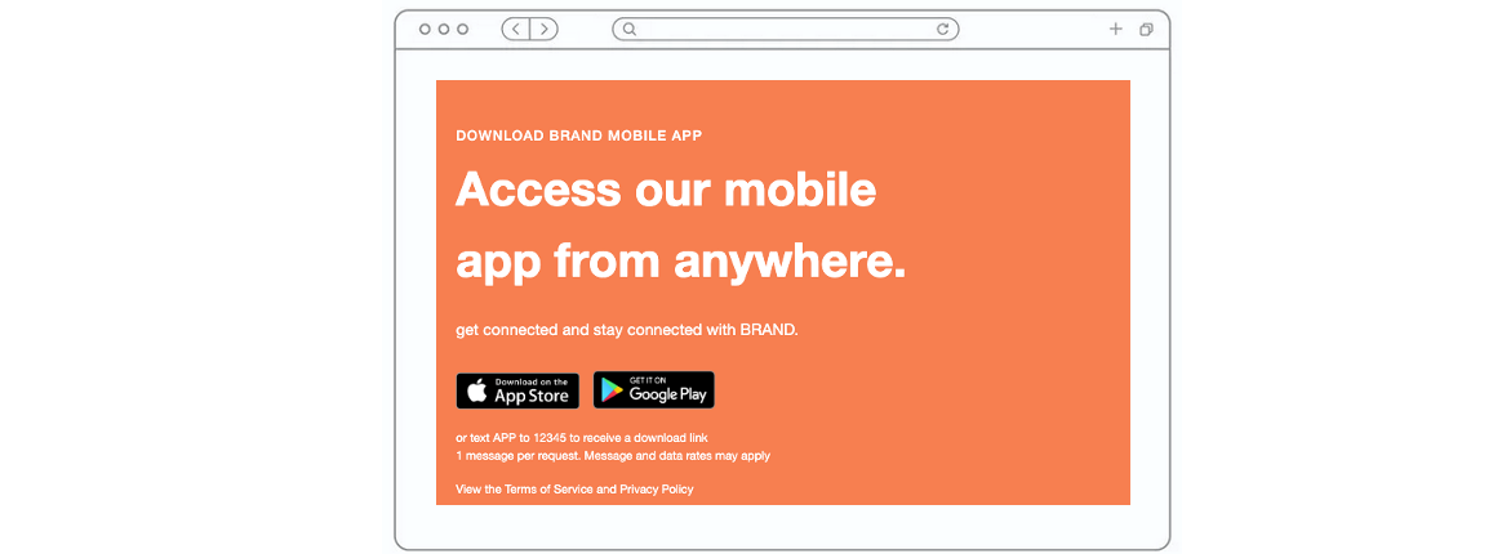
Message flow - Example MT for one-time app download
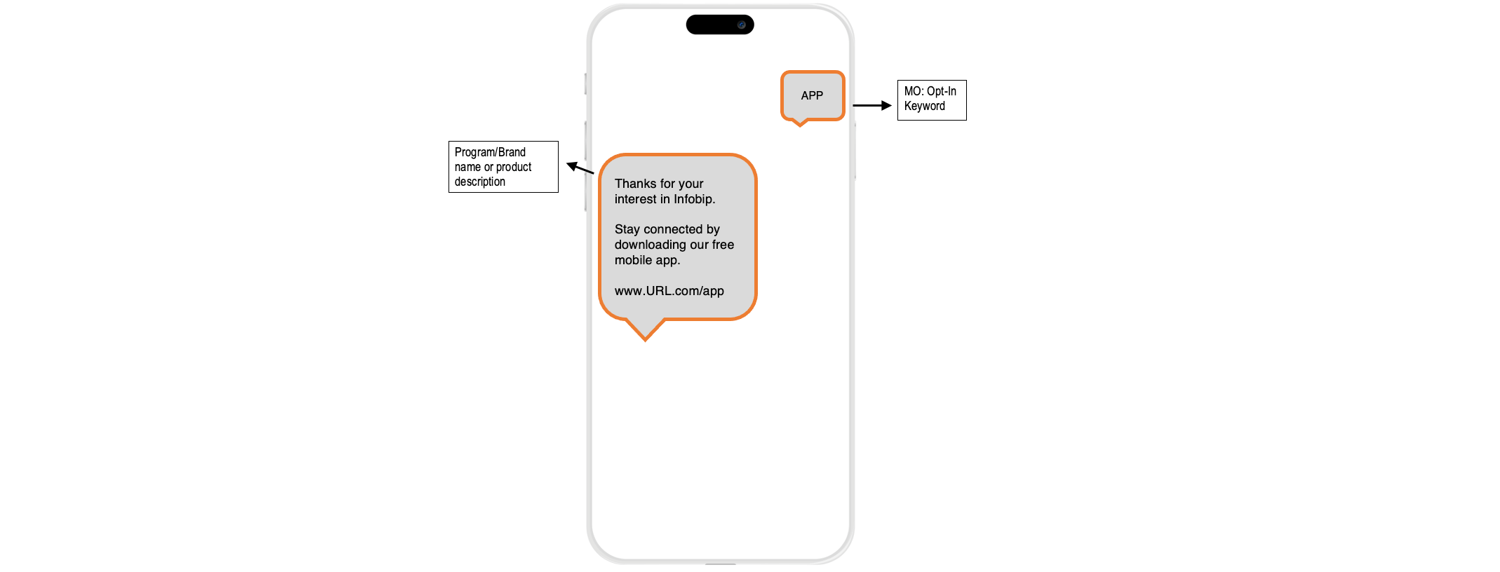
Example: Keyword opt-in for recurring message program
Call-to-action for recurring message with keyword opt-in
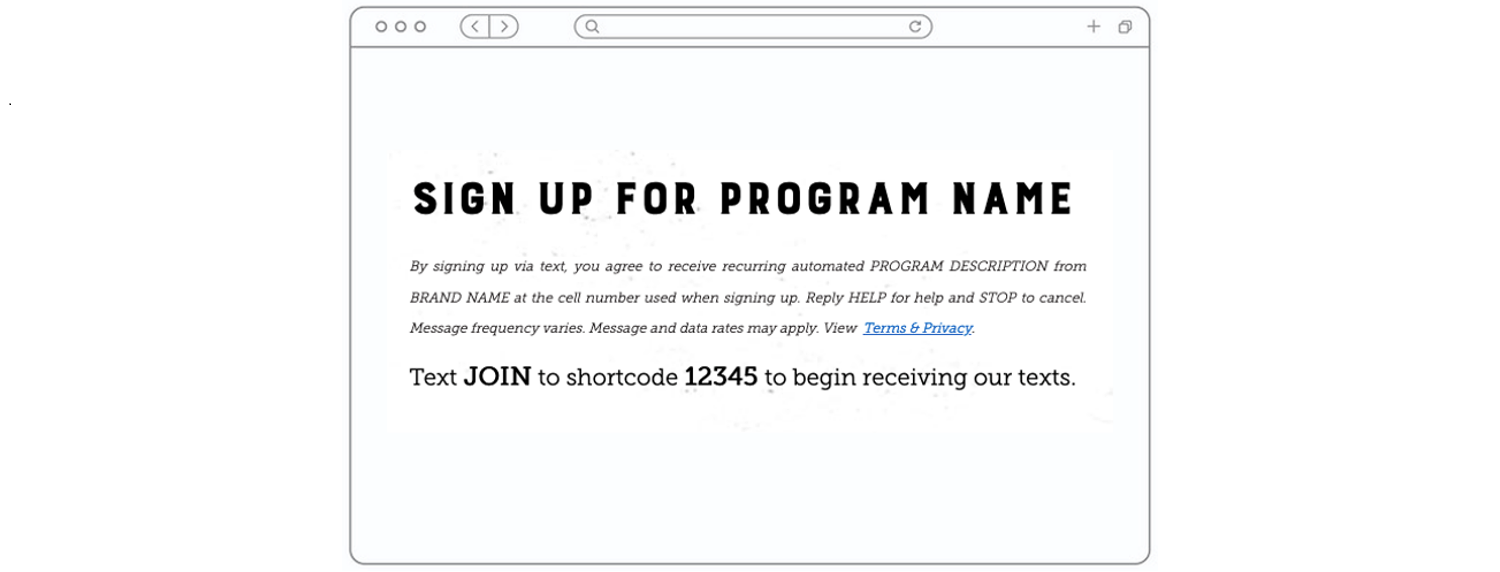
Message flow - Example confirmation MT for keyword opt-in

Robust age gates
SHAFT - Robust age gates
Messaging content for controlled substances or for distribution of adult content might be subject to additional carrier review. This type of messaging should include robust age verification (for example, electronic confirmation of age and identity).
Examples of robust age gates include:
Reply with your birthdate xx/xx/xxxx- A web opt-in form field, which requires the user to include their birthday
Asking a user to reply “YES/AGREE” to confirm they are over a certain age is not considered a robust age verification.
Call-to-action for recurring message with web opt-in and robust age gate
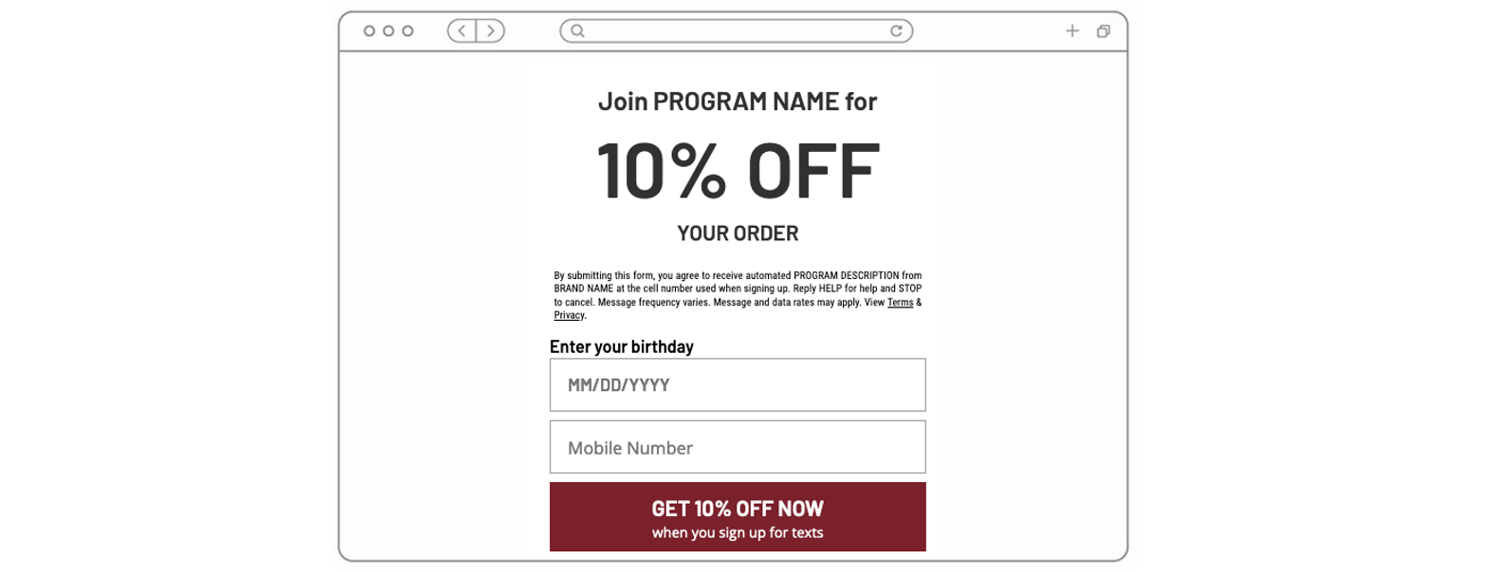
Message flow - Robust age gate (verified)
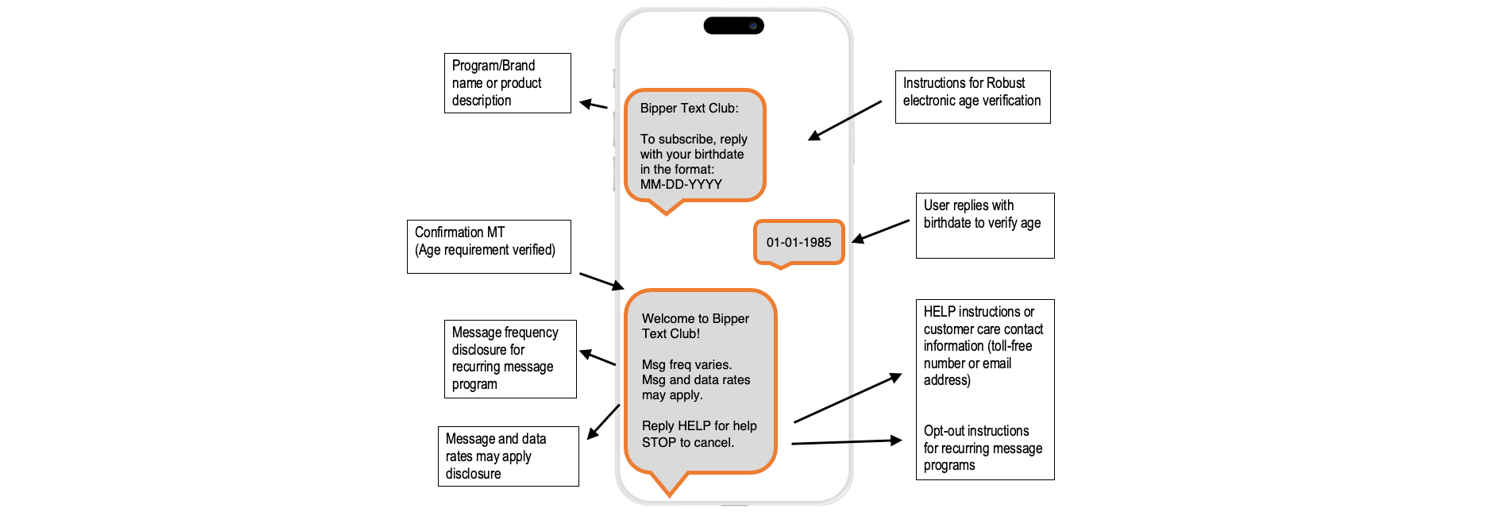
Message flow - Robust age gate (age minimum not met)
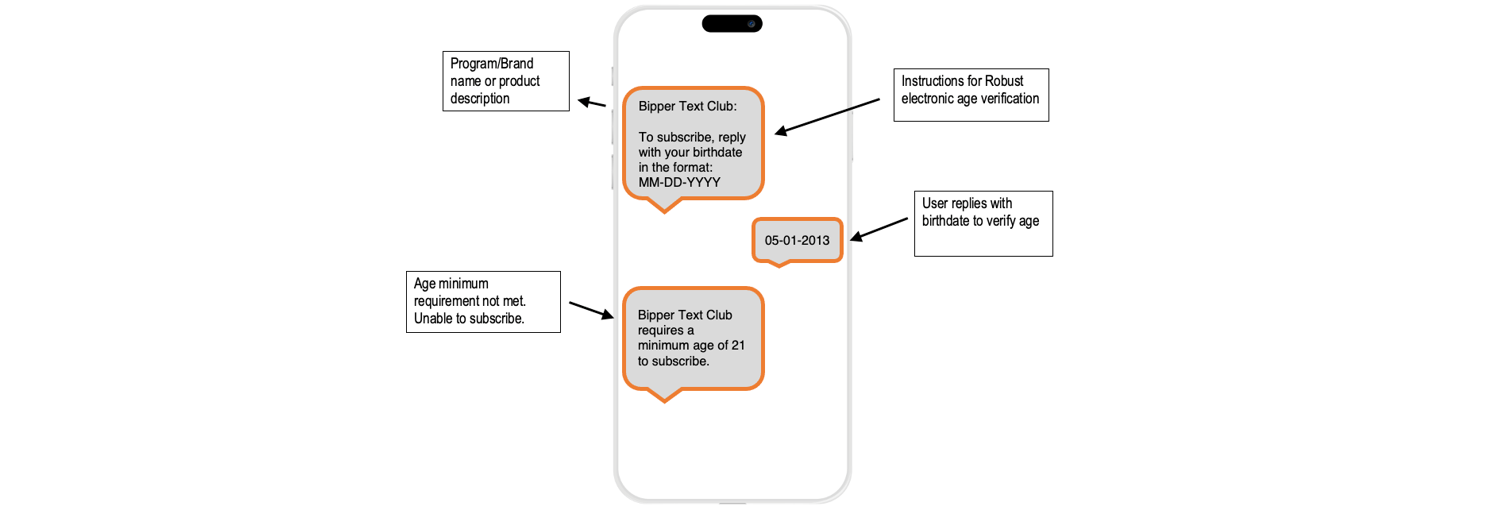
Mandatory keyword responses
HELP messages for all message flows
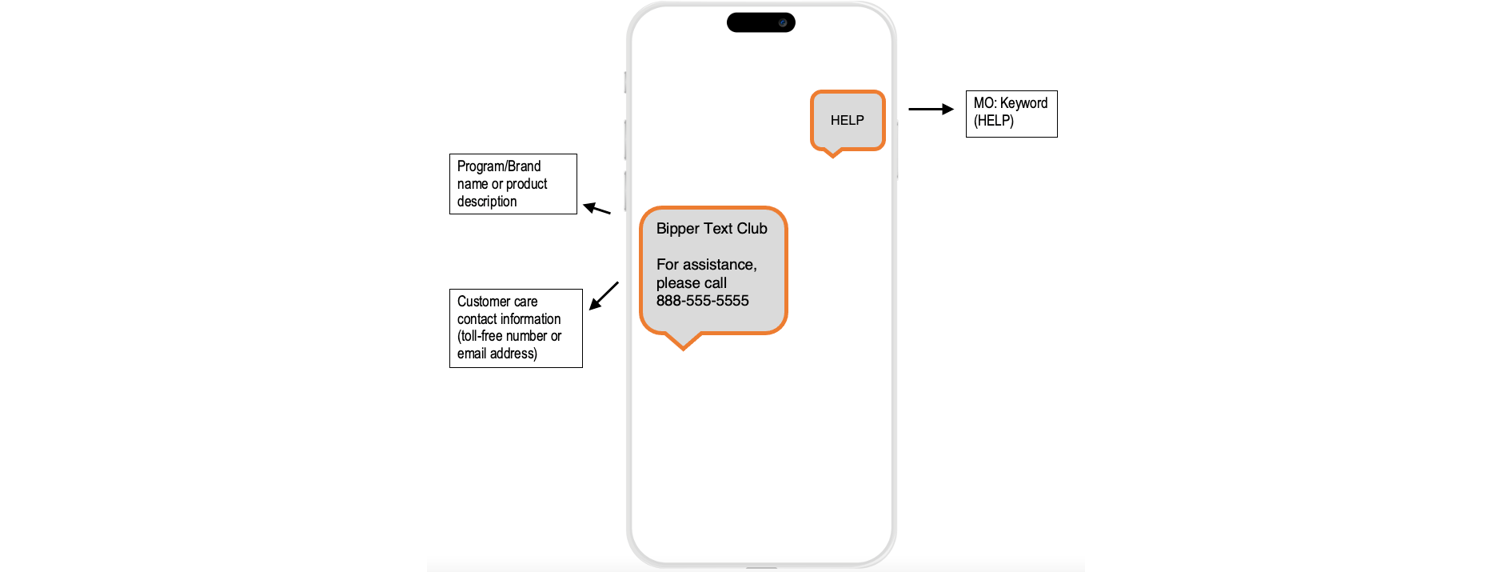
STOP messages for all message flows
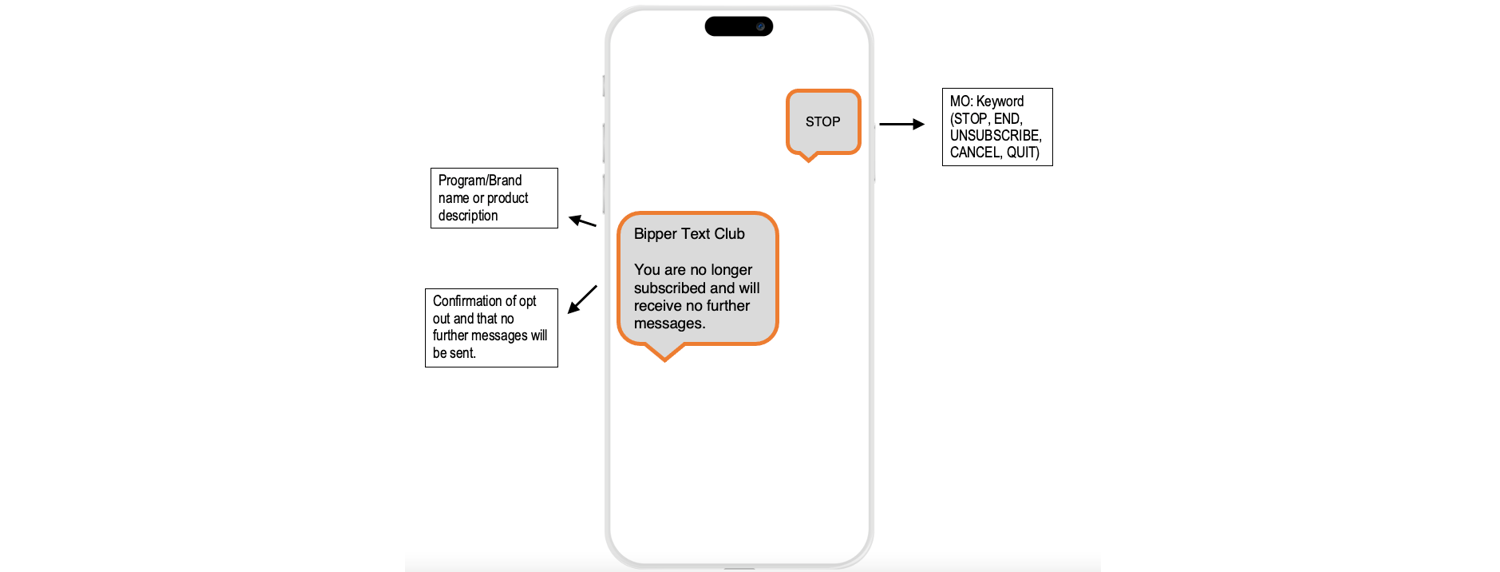
Terms of service and privacy policy
Comprehensive terms and conditions might be presented in full beneath the call-to-action, or they might be accessible from a link in proximity to the CTA.
Pop-ups are not a method for displaying terms and conditions.
Where feasible, message senders may combine multiple program components (for example, call-to-action and terms and conditions)
The following SMS program disclosures must be included within the terms and conditions:
- Program (brand) name.
- Message frequency disclosure (not required for single message programs).
- Product description.
- Customer care contact information.
- Opt-out information (not required for single message programs).
- "Message and data rates may apply" disclosure (not required for FTEU rated programs).
Example: Mobile terms and conditions
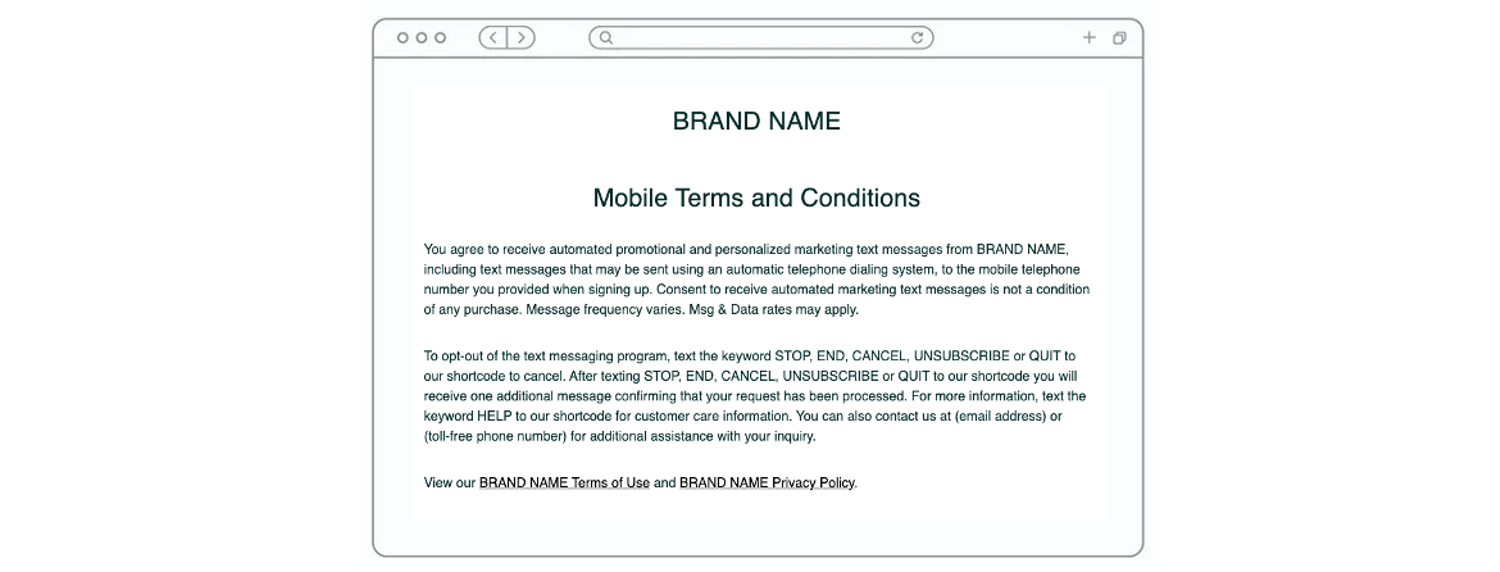
Privacy policy best practices
Message senders are responsible for protecting the privacy of consumers' information and must comply with applicable privacy law. Message senders should maintain a privacy policy for all programs and make it accessible from the initial call-to-action.
When a privacy policy link is displayed, it should be labeled clearly. In all cases, terms and conditions, and privacy policy disclosures must provide up-to-date, accurate information about program details and functionality.
Any mentioning of 3rd party data sharing, renting, or selling is disallowed unless the below disclosure is included.